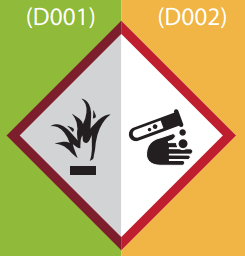 Anyone in a histology lab knows that waste disposal is an important safety concern. In honor of America Recycles Day, November 15th, NSH is sharing some important factors to keep in mind when disposing of laboratory waste.
Anyone in a histology lab knows that waste disposal is an important safety concern. In honor of America Recycles Day, November 15th, NSH is sharing some important factors to keep in mind when disposing of laboratory waste.
A hazardous waste is a waste with properties that make it dangerous or capable of having a harmful effect on human health or the environment.
Characteristic Wastes
The EPA further breaks down hazardous waste into 4 categories based on the characteristics of the waste: Ignitability, Corrosivity, Reactivity, Toxicity.
Ignitability: Liquids with a flash point of 140 degrees Fahrenheit, solids that spontaneously combust, oxidizers and compressed gasses. Ex. Acetone, Acetic Acid, Xylene
Corrosivity: Anything with a pH of less than or equal to 2 or greater than or equal to 12.5, or has the ability to corrode steel at a rate greater than ¼ inch per year. Ex. 1% Hydrochloric Acid, 1% Acetic Acid
Reactivity: Substances that are unstable and routinely experience violent change without detonating; potential for explosive mixture when combined with water. Ex. Ammonical Silver, Chromic Acid
Toxicity: Can pollute ground water when improperly disposed of; can be deadly if ingested or absorbed. Ex. Arsenic, Chloroform
Listed Wastes
Wastes are also considered hazardous if they appear on one of the lists (F, K, P, or U) of hazardous materials. These are known as listed wastes.
The F List identifies wastes from manufacturing and industrial processes that come from non-specific sources, while the K list identifies wastes from specific sectors of industry. The P and U lists identify wastes that are formulations of unused chemicals that are being disposed of. The P and U list is where you will find common histology hazardous wastes. For example, Xylene, Formaldehyde, Toluene, Phenol, Paraldehyde are all U listed wastes. Learn more about types of listed wastes.
Generator Class
When determining how to dispose of your toxic waste, it is also important to know the volume of waste you are generating, as that determines which generator class you fall into.
Large Quantity: Greater than 2,200 lb a month
Small Quantity: 220-2,200 lb a month
Very Small Quantity: Less than 220 lb a month
The EPA has plenty of resources to help businesses determine their generator class. Download the EPA’s Guide for Managing Hazardous Waste for Small Businesses.
NSH members can download the Health and Safety Committee’s Hazardous Waste Infographic on elearn.nsh.org. Hang it in your laboratory to help your lab team identify wastes you commonly use.
Not an NSH member? Join to get access to this infographic and other resources generated by NSH members.
#2018#Blog#LaboratoryOperations